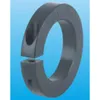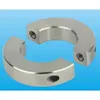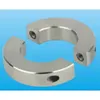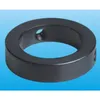A shaft collar is a mechanical component used to secure parts onto a shaft. It acts as a stop, spacer, or retainer in various applications, ensuring precise positioning and preventing lateral movement. Typically made from durable materials like steel, aluminum, or plastic, shaft collars are essential in machinery, automotive systems, and industrial equipment. They come in different designs, such as set screw collars, clamp-style collars, and two-piece collars, each suited for specific needs based on load capacity, ease of installation, and environmental factors.
Understanding the parameters of shaft collars helps in selecting the right product for your application. Below are the critical specifications detailed in lists and tables for clarity.
| Shaft Diameter (inches) | Collars Outer Diameter (inches) | Width (inches) | Material | Max Holding Force (lbs) |
|---|---|---|---|---|
| 1/4 | 1 | 3/8 | Steel | 500 |
| 1/2 | 1.5 | 1/2 | Aluminum | 300 |
| 3/4 | 2 | 5/8 | Stainless Steel | 800 |
| 1 | 2.5 | 3/4 | Plastic | 100 |
| 1.5 | 3 | 1 | Steel | 1200 |
| Parameter | Description | Typical Range |
|---|---|---|
| Holding Force | The maximum axial load the collar can withstand without slipping. | 100 - 2000 lbs |
| Temperature Range | Operating temperatures the material can endure without degradation. | -40°F to 500°F (-40°C to 260°C) |
| Corrosion Resistance | Ability to resist rust and chemical damage, rated by standards like ASTM. | Varies by material (e.g., stainless steel: high) |
| Installation Torque | Torque required for set screws or clamping mechanisms. | 5 - 50 in-lbs |
What is the primary function of a shaft collar?
A shaft collar primarily functions as a mechanical stop, spacer, or retainer on a shaft. It prevents components from moving axially along the shaft, ensuring precise positioning in assemblies like motors, conveyors, and driveshafts.
How do I choose the right shaft collar for my application?
Select based on shaft diameter, load requirements, environmental conditions, and installation needs. For heavy loads, use steel clamp-style collars; for corrosion resistance, opt for stainless steel or plastic; and for easy installation in tight spaces, consider two-piece collars.
Can shaft collars be reused?
Yes, many shaft collars, especially clamp-style and two-piece types, can be reused multiple times without significant wear. Set screw collars may require occasional screw replacement if over-tightened, but overall, they are designed for durability and reusability.
What are the common mistakes when installing shaft collars?
Common errors include over-tightening set screws, which can damage the shaft; under-tightening, leading to slippage; misalignment during installation; and using the wrong size or material for the application, reducing effectiveness and lifespan.
Are there shaft collars for high-temperature environments?
Yes, shaft collars made from materials like heat-treated steel or specialty alloys can withstand high temperatures up to 500°F (260°C). Always check the manufacturer's specifications for temperature ratings to ensure compatibility.
How does a clamp-style shaft collar differ from a set screw collar?
A clamp-style collar uses a uniform clamping force around the shaft, minimizing surface damage and providing higher holding power. In contrast, a set screw collar relies on screws pressed into the shaft, which can cause indentations and are better for lighter duties.
Can I customize shaft collars for unique applications?
Absolutely. Many manufacturers offer custom shaft collars with specific dimensions, materials, finishes, or features like threading or branding. Provide detailed requirements for tailored solutions.
What maintenance do shaft collars require?
Minimal maintenance is needed. Regularly inspect for wear, corrosion, or loosening, especially in high-vibration environments. Lubricate threads or clamping mechanisms if specified, and replace if damage affects performance.





